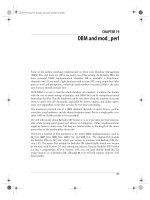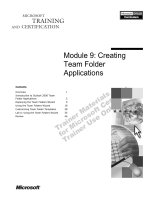Chapter 19: Distributed Applications ppt
Bạn đang xem bản rút gọn của tài liệu. Xem và tải ngay bản đầy đủ của tài liệu tại đây (352.75 KB, 76 trang )
William Stallings
Data and Computer
Communications
Chapter 19
Distributed Applications
Abstract Syntax Notation One
ASN.1
Used to define format of PDUs
Representation of distributed information
Representation of operations performed on
transmitted data
Terms Relevant to ANS.1
Abstract Syntax
Describes generic structure of data
Data Type
Named set of values
Encoding
Sequence of octets used to represent data value
Encoding Rules
Mapping from one syntax to another
Transfer Syntax
Way data represented in bit patterns while in transit
Use of Abstract and Transfer
Syntaxes
ASN.1 Concepts
Module definition
Structured definition of a data structure using ASN.1
Name of module used as abstract syntax name
Form of Modules
<modulereference>DEFINITIONS::=
BEGIN
EXPORTS
IMPORTS
AssignmentsList
End
EXPORTS
Definitions which may be imported by other modules
IMPORTS
Definitions to be imported from other modules
AssignmentList
Type assignments, value assignments, macro definitions
<name>::=<description>
Lexical Conventions
Layout not significant
Comments delimited by pair of hyphens ( ) at
start and pair of hyphens or end of line end of
comment
Identifiers, type references and module names
consist of upper and lower case letters, digits
and hyphens
Identifier starts with lower case letter
Type reference or module name begins with
upper case letter
Built in type consists of all upper case letters
Abstract Data Types
Collection of values
Simple
Atomic
No components
Structured
Has components
Tagged
Derived from other types
Other
Include CHOICE and ANY types (see later)
Tag Classes (1)
Every data type (except CHOICE and ANY) has
associated tag
Universal
Generally useful
Application independent
Defined in standard
e.g. Boolean, Integer, Real
Tag Classes (2)
Application wide
Relevant to particular application
Context specific
Relevant to particular application
Applicable in limited context
Private
User defined
CHOICE and ANY
Data types without tags
When value assigned, type also assigned
Type assigned at run time
CHOICE
List of alternative known types
Only one type used to create value
ANY
Arbitrary value
Arbitrary type
Subtypes (1)
Derived from parent type
Restricted subset of values
May be nested
Single value subtype
Explicit listing of all valid values
Contained subtype
Used to form new subtype from existing subtypes
Includes all values of subtypes it contains
Value range subtype
Real and Integer only
Specify endpoints of range
Subtypes (2)
Permitted alphabet constraint
Only character string
All values that can be constructed using sub-alphabet
Size constrained
Limits number of items in type
e.g. number of bits in bit type
Inner type constraint
Applied to SEQUENCE, SEQUENCE OF, SET, SET OF,
CHOICE
Only values from parent that satisfy one or more
contraints
PDU Example (part 1)
PDU Example (part 2)
PDU Example (part 3)
Network Management - SNMP
Simple Network Management Protocol
Networks are becoming indispensable
More complexity makes failure more likely
Require automatic network management tools
Standards required to allow multi-vendor
networks
Covering:
Services
Protocols
Management information base (MIB)
Network Management Systems
Collection of tools for network management
Single operator interface
Powerful, user friendly command set
Performing most or all management tasks
Minimal amount of separate equipment
i.e. use existing equipment
View entire network as unified architecture
Active elements provide regular feedback
Key Elements
Management station or manager
Agent
Management information base
Network management protocol
Management Station
Stand alone system or part of shared system
Interface for human network manager
Set of management applications
Data analysis
Fault recovery
Interface to monitor and control network
Translate manager’s requirements into
monitoring and control of remote elements
Data base of network management information
extracted from managed entities
Agent
Hosts, bridges, hubs, routers equipped with
agent software
Allow them to be managed from management
station
Respond to requests for information
Respond to requests for action
Asynchronously supply unsolicited information
Management Information Base
MIB
Representation of network resources as objects
Each object a variable representing one aspect
of managed object
MIB is collection of access points at agent for
management of station
Objects standardized across class of system
Bridge, router etc.
Network Management Protocol
Link between management station and agent
TCP/IP uses SNMP
OSI uses Common Management Information
Protocol (CMIP)
SNMPv2 (enhanced SNMP) for OSI and TCP/IP
Protocol Capabilities
Get
Set
Notify
Management Layout
May be centralized in simple network
May be distributed in large, complex network
Multiple management servers
Each manages pool of agents
Management may be delegated to intermediate
manager









